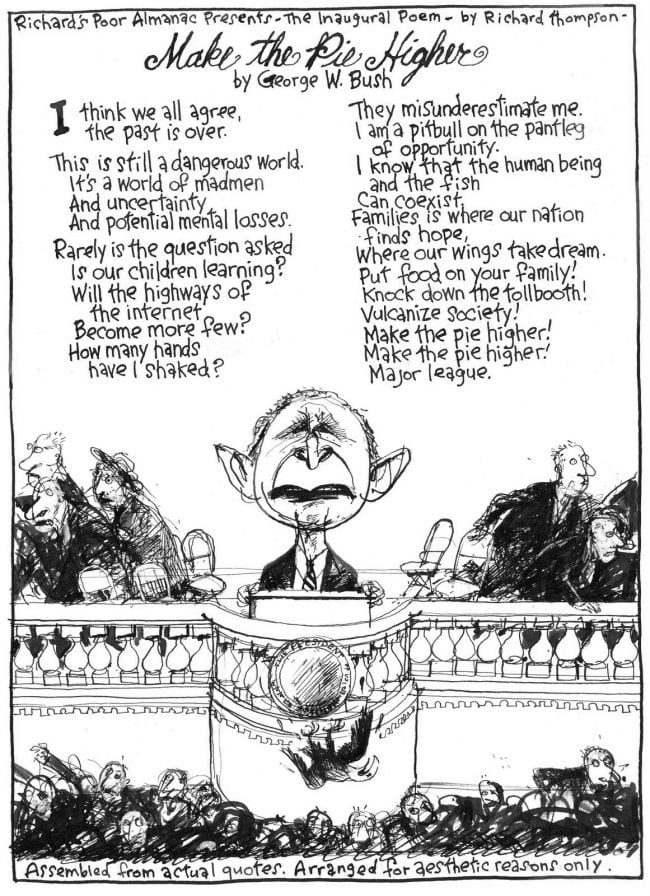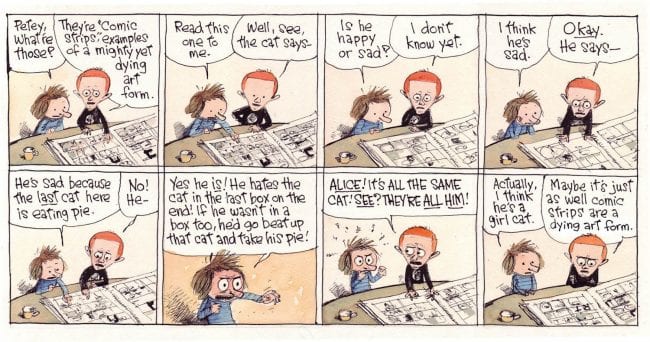"He was my great friend, first and last. In between, I recognized that he was a breathtaking talent, an artist who was better at writing and drawing than most people will ever be at anything." —Nick Galifianakis, cartoonist, Washington Post
Richard Thompson, illustrator and creator of the syndicated comic strip Cul de Sac, passed away in northern Virginia on Wednesday, July 27, 2016 due to complications from Parkinson’s disease. He was 58 years old.
Thompson was born in Baltimore on October 8, 1957. He was a voracious reader from a young age, and was particularly drawn to Winnie the Pooh and the works of Charles Addams and Dr. Seuss. His parents nurtured his love of illustration by enrolling him in extracurricular classes at the Corcoran Gallery of Art. Thompson continued his formal art education at Montgomery County Community College, although he dropped out prior to graduation (which, Thompson proudly noted, did not preclude him from earning the university’s Milton F. “Sonny” Clogg Alumni of the Year Award in 2004).
In 1982, Thompson applied for a position at The Washington Post, which brought him to the attention of art director Francis Tanabe. Tanabe immediately hired him as a freelance artist, and the association would continue for nearly three decades. Thompson contributed regularly to both The Washington Post and The Washington Post Magazine, and was the newspaper’s unofficial staff artist by 1985. Thompson provided illustrations for Joel Achenbach’s Washington Post column and Gene Weingarten’s column in The Washington Post Magazine.
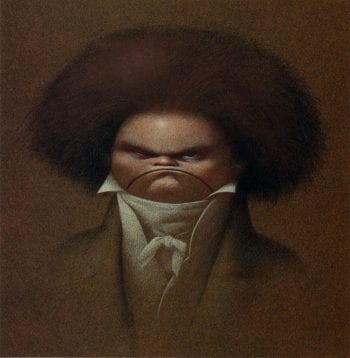
“Richard was a successful working illustrator long before most people outside of a small world of editors and other illustrators ever paid attention."
Many of Thompson’s earliest assignments for publications came through art director Bono Mitchell, who became one of his closest friends over the course of their 34-year working relationship. His reputation as a fast, reliable, and prolific illustrator earned him notoriety as an artist’s artist, with a who’s who of clients including The New Yorker, National Geographic, and U.S. News and World Report, for whom he contributed more than 400 caricatures over the course of nine years.
Early accolades from Thompson’s peers were the Gold and Silver Funny Bone Awards from the Society of Illustrators in 1989, and 1995 NCS Division Awards (also known as the “Silver Reubens”) from the National Cartoonists Society, in the categories of Newspaper Illustration and Magazine Illustration.
With encouragement from editor and collaborator Gene Weingarten, Thompson found an ideal showcase for his own writing in the form of Richard’s Poor Almanac, a weekly Sunday panel featured in The Washington Post. The sprawling, madcap Almanac presented “misinformation in handy cartoon form” on subjects ranging from traditional almanac fodder like weather phenomena and local fauna to entertainment and political news. “The ideal cartoon [for the Almanac] was made up off the top of my head with no research, with only its own comic logic holding it together,” noted the artist in The Art of Richard Thompson.
The most popular installment of Richard’s Poor Almanac, however, was carefully researched by Thompson. Upon learning that George W. Bush had opted not to invite an official poet to his inauguration ceremony in January 2001, Thompson composed his own poem from Bush malapropisms, and assembled them into a free-form verse entitled “Make the Pie Higher”. The cartoon was widely circulated online over the next year, was set to music by multiple composers, and earned its own entry on the fact-checking website Snopes.com.
The following year, Tom Shroder, Thompson’s Almanac editor, suggested that Thompson develop a family comic strip for The Washington Post Magazine. Building upon concepts established in Richard’s Poor Almanac, Thompson created a weekly feature called Cul de Sac, documenting the lives of the D.C. suburbs-based Otterloop family, whose surname was inspired by the Capital Beltway’s notoriously congested “Outer Loop.”
The weekly, watercolored incarnation of Cul de Sac launched in The Washington Post Magazine on February 14, 2004, as the irresistible force known as Alice Otterloop exploded onto the scene, while her immovable object brother Petey stood nervously off to the side. Many of the core cast members, including the extended Otterloop family, Alice’s teacher and fellow classmates at the Blisshaven Academy preschool, and the beleaguered class guinea pig Mr. Danders debuted in the Sunday feature.
Universal Press Syndicate Editor-in-chief Lee Salem contacted Thompson in 2005 to express admiration for his “Make the Pie Higher” cartoon and their subsequent correspondence led to the development of Cul de Sac as Thompson’s first attempt at syndicated daily comic strip “after almost fifty years of dawdling,” according to the artist. Cul de Sac launched with an impressive 70 newspapers on September 9, 2007, and immediately garnered accolades from Thompson’s fellow cartoonists. Less than a year after its debut in syndication, his peers in the National Cartoonists Society nominated Cul de Sac for Best Newspaper strip of 2008, with a subsequent nomination in 2010.
The strip’s first book collection, Cul de Sac: This Exit, was published by Andrews McMeel in September 2008. Lee Salem approached Calvin and Hobbes creator Bill Watterson to write the book’s introduction, sensing a kinship between the two artists. Watterson agreed, and his glowing endorsement of Cul de Sac marked one of his first public statements of any kind since the conclusion of his own strip more than a decade earlier.
“I thought the best newspaper comic strips were long gone, and I've never been happier to be wrong,” effused Watterson. “Richard Thompson's Cul de Sac has it all—intelligence, gentle humor, a delightful way with words, and, most surprising of all, wonderful, wonderful drawings.” The two struck up a friendship, and Watterson would visit Thompson at his Virginia home once or twice a year.
Cul de Sac’s reputation and circulation grew steadily over the next several years, eventually appearing in more than 150 newspapers. At the peak of the strip’s popularity, Thompson was diagnosed with Parkinson’s disease, a chronic and progressive disorder of the nervous system that affects movement. He had initially dismissed his symptoms as exhaustion relating to the addition of a daily comic strip to his already-full workload, but longtime friend Nick Galifianakis urged Thompson to visit a specialist, and the diagnosis was confirmed in the summer of 2009.

The comics community rallied around Thompson upon news of his diagnosis. The most notable of these efforts was the foundation of Team Cul de Sac, whose fundraising efforts benefited the Michael J. Fox Foundation for Parkinson’s Research. Friend and self-proclaimed Richard Thompson fanboy Chris Sparks spearheaded the organization’s most ambitious project, the Team Cul de Sac book and original art auction, featuring the works of more than 100 cartoonists, including Doonesbury creator Garry Trudeau, Pearls Before Swine creator Stephan Pastis, award-winning children’s book creator Mo Willems, and Bill Watterson, whose painting of Petey Otterloop was his first public artwork since the conclusion of Calvin and Hobbes in 1995. To date, Sparks and Team Cul de Sac have raised more than $200,000 for Parkinson’s research efforts.
Thompson continued to produce new Cul de Sac strips throughout his treatment for Parkinson’s disease, and in 2011, he received the National Cartoonists Society’s highest honor, the Reuben Award, as 2010’s outstanding cartoonist of the year. He received a standing ovation at the award ceremony at the Fairmont Copley Plaza in Boston, and Thompson humbly thanked his friends and family in his brief, self-effacing acceptance speech.

In early 2012, Thompson announced a brief sabbatical so that he could focus on treatment for Parkinson’s, and his friends rallied around him once again as a series of artists filled in for him during his absence. Guest artists Michael Jantze (The Norm), Corey Pandolph (The Elderberries), Lincoln Peirce (Big Nate), Stephan Pastis (Pearls Before Swine), Ruben Bolling (Tom the Dancing Bug), and Mo Willems (Don’t Let the Pigeon Drive the Bus!) guided Cul de Sac through March, when Thompson returned to the strip aided by children’s book illustrator Stacy Curtis, who inked Thompson’s penciled roughs.
Thompson’s health continued to decline throughout the summer, and after two months of irregular updates and reruns of past strips, he reluctantly announced his retirement in August to focus on his medical treatment. ”At first [Parkinson’s] didn’t affect my drawing, but that’s gradually changed,” he lamented in a statement released through his syndicate. “Last winter, I got an excellent cartoonist, Stacy Curtis, to ink my roughs, which was a great help. But now I’ve gotten too unreliable to produce a daily strip.”
The final installment of Cul de Sac appeared in newspapers on Sunday, September 23, 2012. Thompson had intended to produce a new installment to mark the occasion, but as he self-deprecatingly noted online the preceding Saturday, "Spoiler alert – I couldn’t draw a new Sunday so tomorrow’s is a repeat too. Sorry! I’ll do better next time."
Thompson’s selection for the final strip was a quintessential Cul de Sac Sunday comic, one that had originally run in The Washington Post Magazine and had been re-worked as a Sunday comic in February 2007. The strip depicts a typical conversation between Alice and Petey as he introduces her to "'comic strips,' examples of a mighty yet dying art form." Thompson often cited this as his favorite installment of Cul de Sac, because "it's got drama, comedy and meta-ness, and it makes a point that's self-deprecating enough to be self-loathing.
“I still like this strip a lot. It's simple, built on misunderstanding and confusion, and it shows Alice and Petey at their best. I wouldn't take Petey's curtain line too seriously. He is a bit of a pessimist, after all.”
In the months following his retirement, his friends and colleagues set to work on multiple retrospectives celebrating Thompson’s live and his art. Curator Caitlin McGurk coordinated a solo exhibition of Thompson’s art, “The Irresistible Force Meets the Immovable Object: A Richard Thompson Exhibition,” debuted alongside an exhibition of Bill Watterson's Calvin and Hobbes at Ohio State University’s Billy Ireland Cartoon Research Library and Museum in March 2014.
Two months later, Andrews McMeel Publishing released The Complete Cul de Sac, the (nearly) definitive collection of Thompson’s strip, featuring an introduction by Art Spiegelman and running commentary from Thompson throughout. (Noting that 100 Washington Post Magazine strips were skipped in The Complete Cul de Sac’s publication, Thompson, Mike Rhode, and Chris Sparks took it upon themselves to self-publish a companion volume, Compleating Cul de Sac, the following year. Picture This Press is publishing an expanded version in time for the 2016 Small Press Expo.)
November 2014 saw the long-anticipated release of The Art of Richard Thompson, a career-spanning collection edited by David Apatoff, Nick Galifianakis, Mike Rhode, Chris Sparks, and Bill Watterson. That same month saw the release of a short documentary of the same title, directed by Bob Burnett and produced by Thompson’s friend and neighbor Andy Hemmendinger.

Thompson was able to witness one final tribute to his work in June 2016, as the Arlington, Virginia-based Encore Stage & Studio presented a live community-theater adaptation of Cul de Sac. The strip was adapted into a play written by Thompson’s wife, Amy, who had gone back to school to get a degree in theater when Richard was too ill to work. When describing Richard in the play’s official press release, she succinctly noted, “He never wanted to be anything other than a cartoonist.”
Thompson is survived by his wife, Amy, his daughters, Emma and Charlotte, his father, Richard, and his brother, Tim. The family asks that in lieu of flowers, a donation be made to the Michael J. Fox Foundation for Parkinson’s Research, either directly or through Team Cul de Sac.
There will be a public memorial ceremony in Washington, D.C. at the National Press Club on Saturday, August 27th.
Andrew Farago is the Curator of San Francisco’s Cartoon Art Museum, and with his wife Shaenon K. Garrity was one of the artists who contributed to Team Cul de Sac.
Special thanks to Mike Rhode for his assistance with this article.
—————————————
Pete Docter on Richard Thompson:
Richard Thompson’s skills as a consummate storyteller earned him the admiration of Pete Docter, director of Pixar’s Monsters, Inc. and Up.
“No matter how great a movie's concept or plot, the thing the audience really connects with are the characters. Finding those characters is a long road full of experiments and many people. At Pixar sometimes we ask outside artists to contribute sketches and paintings for the character designs,” notes Docter.
“I called Richard when Inside Out was still in the early concept phase. We at Pixar had played around enough with the plot to know we wanted the film’s central relationship to be between Joy and Sadness—who was, at that time, male, and named ‘Bud’ (I thought it’d be too weird and on-the-nose to name the emotions after their job).
“As a fan of Cul de Sac, I was in awe of Richard’s ability to develop characters that were so wonderfully unique, specific and truthful. Alice Otterloop specifically seemed very close to the spirit of what we were after for Joy, so he seemed like he’d have a lot to offer. Rather than doing design work, I asked Richard to draw up some comic strips. My hope was this would help him focus on character attitude and acting, and not worry about what the characters looked like. This turned out to work well. Though both Joy and Sadness went through some huge changes, I think his work did show some of the entertainment possibilities that we were able to take advantage of in the film.”
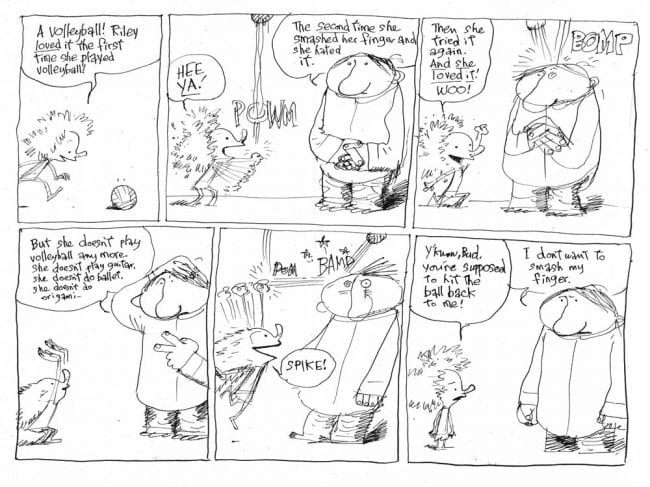

Inside Out was a massive critical and commercial success, winning the 2015 Academy Award, Golden Globe, and British Academy Film Award for Best Animated Feature.
Mo Willems on Richard Thompson:
Cartoonist Mo Willems, best known for his award-winning children’s books, was one of six guest artists who filled in for Richard Thompson on Cul de Sac during his first medical leave in 2012.
“Richard was a genius with a heart as adept and beautiful as his line-work. A loss for cartooning, and for me personally.
"I went out of my way to meet Richard specifically because I had never met Sparky Schulz and after that I wasn't going to let pass an opportunity to tell someone who inspired me how wonderful their work was.
“I expected him to be polite and maybe even flattered, but I didn't expect him to become a friend. Over the years Richard quietly showed me the meaning of bravery and the power of humor.
“By the time I last saw him, it took labor and concentration for him to speak, and even then it was very difficult to understand him. I remember him trying to communicate something to me, something I just couldn't understand for the first few attempts.
“Did he need something? Something important?
“Nope, it was just a punch line to something I'd just said. Funny always."
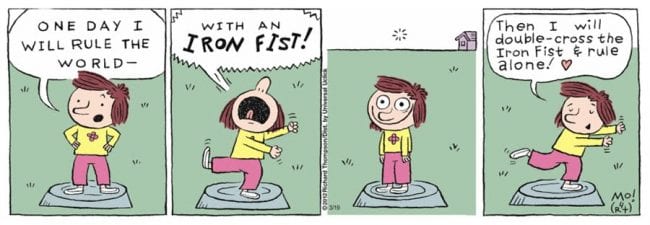
Shena Wolf on Richard Thompson:
Shena Wolf, Acquisitions Editor at Universal Uclick, the syndicate arm of Andrews McMeel Universal, served as Richard Thompson’s final editor on Cul de Sac.
“Working as Richard’s editor during the last years of Cul de Sac is unquestionably one of the highlights of my career. His work shows his genius, and it speaks for itself (and will continue to do so forever).
“Richard was hilarious and warm, always worried that his struggle with deadlines had caused us problems in the office (everybody here loved him, so this concern was unfounded). I am devastated by his passing, but grateful for his friendship.”


